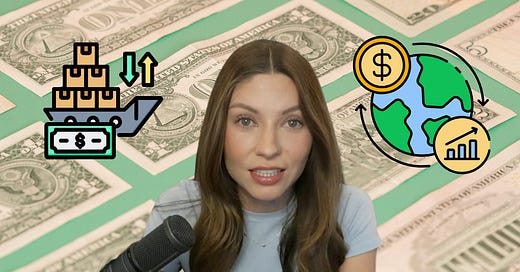Trump to Cut Taxes for Earners Under $150K, but Price Hikes May Offset the Savings
Translating tariff policies, and Trump's economic plan, for the people. Economics in normal human words.
Trump’s Commerce Secretary, Howard Lutnick, was asked in an interview with CBS yesterday if the administration’s economic policies would cause a recession, he replied: “It’s worth it.”
Lutnick then brought up Trump’s plan to cut income taxes: “I know what his goal is. No tax for anybody who makes less than 150,000 dollars a year. That’s his goal, and that’s what I’m working for.” Sounds like a great idea, I think we should remove income taxes for everyone earning below $150k annually.
However, along with the Trump administration’s other economic policies, an income tax cut would be merely offsetting the dollars Americans would pay in price increases as a result of his sweeping tariff plan: 25% on all imports from China, Mexico, and Canada.
The Wall Street Journal’s Chief Economist, Greg Ip, shared on X some numbers from a recent Goldman Sachs report on the impact of Trump’s tariffs, estimating “foreigners pay 15%, U.S. importers/intermediaries 15%, and U.S. consumers 70%.” While I wouldn’t take public policy recommendations from Goldman Sachs, I generally trust their numbers when it comes to market analysis.
WSJ’s Chief Economist added the following post to his thread on X: “Goldman also estimates that when you include how much domestic product prices rise in response to costlier imports, the cost to U.S. consumers equals 100% of the tariff.”
What exactly does that mean? Let’s break this down. Immediately, the tariff is paid by importers. The importers do not like paying higher prices, no one does. So, the importer will adjust the fees they charge to the foreign companies they buy from to help cover the cost of the tariff. Importers and intermediaries will also increase prices when they sell the imported goods to consumers within the U.S., to offset the rest of what they paid in tariffs.
Who are importers? The people or companies purchasing goods from the tariffed countries (Canada, Mexico, China) and bringing them into the US.
Example: if I order a Korean skincare product from Sephora, then Sephora has imported the product and paid the tariff when it came into the U.S. Korea, so Sephora may charge the Korean company a fee to import the product and help cover the tariff. Sephora may also raise the price of all Korean skincare products to offset the tariffs they pay, and the Korean company may increase their price point to cover the fees charged to them by Sephora.
Who are intermediaries? Not the same as importers, intermediaries might be shipping companies, who bring goods into the U.S. from other countries, but have not directly purchased the foreign goods.
Example: if I order a Korean skincare product on Tik Tok shop, and it is shipped by UPS, the tariff would be charged to UPS when my skincare arrives from Korea at port in the United States. UPS might charge Tik Tok shop or the Korean company a fee to cover the tariff as a part of their business arrangement. The Korean company or Tik Tok shop may increase the price to cover the cost of the tariff.
(Right now, Trump has pushed back his plans to end the current exemption for foreign products shipped to the U.S. if the sale is under $800, but he still has promised to close this tariff loophole.)
Together, importers and intermediaries, after pushing costs onto consumers and foreign sellers, end up covering about 15% of the tariff. According to Goldman’s estimates, foreign sellers will cover about 15% of the tariff as well through fees, and consumers will cover the remaining 70%, through price increases.
In our modern economy, publicly traded companies tend to promise steady returns to shareholders, which means consistent profit margins. Importers tend to raise prices on not only the products they pay tariffs to import, but the other products they sell too. They do this to avoid sticker shock (sudden price increases that discourage consumers from buying products and services).
Basically, they spread out the price increases across many products to make back any money they spent covering the tariffs. This is what WSJ’s Chief Economist means when he says, “Goldman also estimates that when you include how much domestic product prices rise in response to costlier imports, the cost to U.S. consumers equals 100% of the tariff.”
Tariffs don’t just impact companies that import foreign goods to resell, some companies also import raw goods and use them in manufacturing. While a product may be made in the U.S., it may be built with Canadian energy, Canadian lumber, Mexican auto parts, or be wrapped in Chinese plastic. The scope of a 25% tariff on all imports from Mexico, Canada, and China is massive.
So, not paying income taxes sounds great, more money in our paychecks. However, the same amount of money will be in our bank accounts after we end up paying higher prices thanks to the costs of tariffs being pushed onto consumers. At the end of the day, Uncle Sam still gets his cut. Here’s how WSJ’s Chief Economist explained this on X: “Tariffs are not a tax cut, but they can finance cuts to other taxes e.g. income taxes. As with all taxes, the incidence of tariffs - who pays it - depends.”
For a longer conversation on the economy, including current recession indicators and a theory about Trump’s tariff back-and-forth, watch my video for Drop Site: “Are We Headed for a Recession?”



Thanks for the great article, Commie Queen ✊🏽